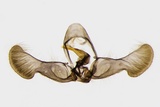Cydia servillana (Duponchel, 1836) Species
Last modified: Dec. 15, 2023, 1:53 p.m.
A very rare and local species. Status is uncertain because it's rarely attracted to light and therefore not often seen, but it's easily attracted with pheromone.
Details
- Classification
- Family: Tortricidae > Subfamily: Olethreutinae > Tribus: Grapholitini > Genus: Cydia > Species: Cydia servillana
- Vernacular names
- Wilgenspiegelmot (NL), Sallow-shoot Piercer, Sallow Gall Moth (EN)
- First mention in Belgium
- De Fré Ch. 1858. Catalogue des Microlépidoptères de la Belgique. — Annales de la Société entomologique belge 2: 45–162. On page 97. view page
- Status
-
Native
Distribution
Imago
Wingspan 11–15 mm. The head, thorax and an irregular basal patch are grey with darker patches. The terminal quarter is marked with grey and light brown with plumbeous stria. Ocellar area with variable sometimes strong black dashes. The white or cream coloured main wing area bears variable clouding of grey and light brown.
Museum specimens
No pictures yet!Specimens in nature
No pictures yet!Caterpillar
Whitish larva with gray dots, the head is brownish black, the nape and anal shield are brown, pinacula large, brownish grey.
Bionomics
The caterpillar lives in a slender twig of one or two years old on broad-leaved willow, causing a slight swelling or gall. In the elongated swelling, it lives in a burrow and feeds on the stalk. The species hibernates in a whitish cocoon inside the gall. Prior to hibernation the larva cuts an escape hole for the adult just above a bud which is silk covered. The adults come rarely to light but are easily attracted with the pheromone of Cydia fagiglandana.
Flight periods
The adults have been observed from late April to mid-July.
Observed on
- Host plant (genera):
- Salix
The larva feeds mainly on Salix caprea, also found on Salix cinerea, Salix aurita and Salix daphnoides.
Habitat
It inhabits margins of lakes and ponds, embankments, marshy habitats, damp woodland edges and wet meadows.

